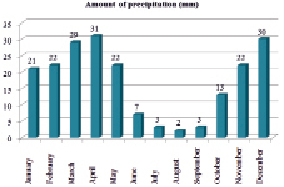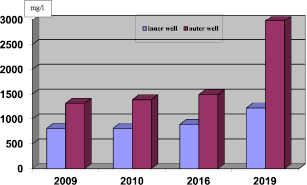Turkestan region, according to the definition of the «National Report on the Conservation and Balanced Use of Biological Diversity», is included in the second group of regions of Kazakhstan on environmental risk. In addition, Turkestan belongs to the Aral Sea region, where according to the document of the National Action Program to Combat Desertification of the Republic of Kazakhstan, it is forecasted that in the Aral Sea region, under the influence of the Aral Sea and the influence of local environmental problems, there will be a further expansion of the ranges of salinization, waterlogging, desertification, depletion and pollution of water bodies, degradation of flora and fauna [1]. This territory is part of the piedmont desert-steppe zone, belongs to the dry subtropics due to a sharp lack of precipitation and an abundance of solar radiation and heat.
The aim of this work is to study the well waters of the mausoleum of H.A. Yasavi and to assess the impact of groundwater on its architecture.
Materials and methods
The object is the well waters of the mausoleum of H.A. Yasavi. The total hardness, content of calcium, magnesium, bicarbonate, sulfate [2-4], and chloride ions was determined by titrimetric method according to the corresponding GOST standards [5-6]. The active reaction of water, characterized by the pH value, was determined by the potentiometric method. The concentration of trace elements (fluoride ions) was determined using standard methods [7-8]. Organoleptic parameters were determined by the method according to the corresponding state Standards [9].
The content of safety indicators (mass concentration of nitrate ions) was determined by the spectrophotometric method according to the corresponding GOST standards [10].
Results and discussion
Due to the fact that the average annual precipitation does not exceed 250 mm even in favorable years, in some years the amount of precipitation decreases to 90-150 mm. Most rainfall occurs in the winter and spring months. In summer, there is practically no rain and therefore high air temperature and the absence of precipitation in the summer months cause a large moisture deficit (Fig. 1).
According to Kazhydromet, the amount of precipitation in 2018 for Turkestan is 554.2 mm (the amount of precipitation during the winter is 76.2 mm), the amount of ions in the precipitation is 21.32 mg / l: sulfate ions – 6.04, chlorides – 2.03, nitrates – 0.51, bicarbonates – 6.54, ammonium – 0.56, sodium – 0.35, potassium – 0.38, magnesium – 0.80, calcium – 4.09 mg / l, The precipitation pH is 6.92. The amount of moisture in the soil profile depends on the amount of evaporation. In soil formation, moisture plays a huge role, since all physicochemical, mechanical, biological, and other processes are associated with soil moisture.
The value of evaporation using the information from the weather station of the Institute «Ecology» in International Kazakh-Turkish University named after H.A. Yasawi are defined by the formula:
Ео – 0,15 nс D0,78 (1 + 0,85w100),
where Ео – monthly rate of evaporation, mm;
n – number of days in a month;
С – a parameter depending on the average ratios between the temperature of water and air, taken equal to 1,4;
D – moisture deficit;
w – wind speed at altitude 100 cm, m /s.
As the calculation results showed, the total evaporation for the year is 1413 mm, and more than 82 % of the total amount falls on the growing season (April-September). Water evaporation is 4-5 times higher than the amount of precipitation.
Scientific research conducted in the area of the mausoleum. H.A. Yasavi, indicate the need to combine the ecological, geochemical and biological characteristics in the spatial and temporal consideration of the elements of the ecological chain: the source of pollution – the surface atmosphere – precipitation – soil cover – plants – water bodies for organizing and adjusting measures to reduce environmental pressure and environmentally dependent pathologies.
As shown by the results of preliminary visual observation by detouring the residential areas adjacent to the object under study and experimental research of the territory and objects adjacent to the architectural complex of the Yasavi Mausoleum, an ecologically crisis situation has developed in relation to this monument. This is due to the transformation of the protected area around the mausoleum into a landfill for solid household and various industrial wastes, not counting other pollution routes. This circumstance indicates the need for drastic measures to improve the environmental situation.

Fig. 1. The monthly changes in rainfall (mm)
In aggregate, various nature factors influence the studied object. The main sources of environmental pollution are combined in two groups:
– natural processes that determine the background content of pollutants in the components of the biosphere (in soil, water, atmospheric air, etc.);
– anthropogenic sources, including a network of intensively constructed facilities, transport accumulations, emissions from numerous boilers of private houses that use solid fuels, parking lots and municipal landfills stretching out over large areas, imperfect sewage systems, many years of unplanned discharge of both solid and liquid agricultural and other waste.
During the expeditionary trips from January 10, 2018 to August 18, 2019, the collection of field material was carried out on the territory of the mausoleum and adjacent territories. Work was carried out to control water bodies, that is, groundwater and groundwater (wells).

Fig. 2. The results of the analysis of water from the inner and outer wells of the mausoleum
Table 1
Composition of well water of the architectural complex of H.A. Yasavi (inside the mausoleum, depth – 3-5 m)
|
№ |
Name of analyzes |
Content of components in water |
Method sensitivity |
MAC in drinking water |
|
1 |
Color, in degrees |
2,314 |
- |
no more 30 |
|
2 |
Turbidity, NTU/dm3 |
5,554 |
- |
2,6-3,5 |
|
3 |
Smell, taste, in points |
0 |
- |
no more 2-3 |
|
4 |
рН |
8,586 |
0,2 |
6,5-9,0 |
|
5 |
Dry residue, mg/dm3 |
1221,0 |
1,0 |
1000-1500 |
|
6 |
Permanganate oxidizability, mg•О/dm3 |
3,64 |
0,01 |
4,0 |
|
7 |
Total hardness, mol / m3 |
9,4 |
0,05 |
7,0 |
|
8 |
Carbonates, mg/dm3 |
n/d |
0,1 |
6,5 |
|
9 |
Hydrocarbonate, mg • eq /dm3 |
0,56 |
0,1 |
6,5 |
|
10 |
Calcium, mg/dm3 |
165,5 |
0,4 |
180,0 |
|
11 |
Ammonium ions and ammonia, mg/dm3 |
0,271 |
0,05 |
2,0 |
|
12 |
Nitrite, mg/dm3 |
0,033 |
0,01 |
3,0 |
|
13 |
Nitrates, mg/dm3 |
5,56 |
0,1 |
45,0 |
|
14 |
Iron, mg/dm3 |
0,42 |
0,01 |
0,3 |
|
15 |
Fluoride, mg/dm3 |
0,37 |
0,02 |
1,2 |
|
16 |
Chlorides, mg/dm3 |
64,4 |
1,0 |
350,0 |
|
17 |
Sulphates, mg/dm3 |
505,0 |
1,0 |
500,0 |
|
18 |
Manganese, mg/dm3 |
0,019 |
0,01 |
0,1 |
Table 2
The results of the analysis of well water of the architectural complex (in the courtyard of the mausoleum, depth – 7-10 m)
|
№ |
Name of analyzes |
Content of components in water |
Method sensitivity |
MAC |
|
1 |
Color, in degrees |
3,680 |
- |
≤ 30 |
|
2 |
Turbidity, NTU/dm3 |
17,65 |
- |
2,6-3,5 |
|
3 |
Smell in points |
1 |
- |
≤ 2-3 |
|
4 |
рН |
7,724 |
0,2 |
6,5-9,0 |
|
5 |
Dry residue, mg/dm3 |
2980,0 |
1,0 |
1000-1500 |
|
6 |
Permanganate oxidizability, mg•О/dm3 |
2,74 |
0,01 |
4,0 |
|
7 |
Total hardness, mol / m3 |
26,9 |
0,05 |
7,0 |
|
8 |
Carbonates, mg/dm3 |
n/d |
0,1 |
6,5 |
|
9 |
Hydrocarbonate, mg • eq /dm3 |
1,35 |
0,1 |
6,5 |
|
10 |
Ammonium ions and ammonia, mg/dm3 |
0,924 |
0,05 |
2,0 |
|
11 |
Nitrite, mg/dm3 |
2,092 |
0,01 |
3,0 |
|
12 |
Nitrates, mg/dm3 |
29,3 |
0,1 |
45,0 |
|
13 |
Iron, mg/dm3 |
1,32 |
0,01 |
0,3 |
|
14 |
Fluoride, mg/dm3 |
0,98 |
0,02 |
1,2 |
|
15 |
Sulphates, mg/dm3 |
1360,0 |
1,0 |
500,0 |
The destruction of the materials of the monument is inevitable, but its speed can increase many times due to the increased aggressive action of saline groundwater. With this in mind, we conducted studies to determine the composition of well water inside and in the courtyard of the mausoleum. The results are presented in tables 1-2 and in fig. 2 and compared with the data obtained in the analysis of these waters of the Research Institute «Ecology» from 2009 to 2019.
As can be seen from Fig. 2, the salinity of water in wells in 2019 compared with 2009-2016. increased approximately on average 1.5 times inside the mausoleum and more than 2.3 times in well water located in the courtyard of the mausoleum.
The observed salinization of groundwater can have a significant negative impact on the condition of the monument. Moisture containing salts, due to capillary uplift and evaporation, saturates the pores of building materials, crystallizing destroys the structure, i.e. the destruction of the foundations occurs, and this will lead to a gradual shrinkage, deforming the walls. This factor is subject to further study to take specific measures to increase the durability of building materials of the mausoleum. In addition to the influence of groundwater on the state of the mausoleum, a significant contribution is made by emissions from various anthropogenic objects.
They contribute to the rapid pollution of the facades and, in combination with atmospheric precipitation, form a chemically aggressive environment that causes the destruction of facade materials (brickwork, plaster, stucco, paint layers, etc.). An environmentally aggressive environment accelerates the natural destruction of monuments due to aging processes.
Conclusions
Thus, any environmental damage – first of all, caused by pollution to architectural monuments and other categories of cultural heritage, should be recorded and, upon the fact of damage, measures should be taken to preserve the mausoleum Н.A. Yasavi.

